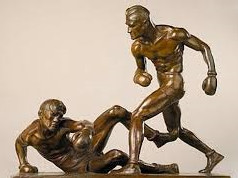When Art Was An Olympic Event
Great athleticism can be seen as a form of art, but can art itself be regarded as a sporting event ? Maybe not with strength and endurance, but with style and beauty.
Between 1912 and 1948 seven Olympiads incorporated art into their programs of competition with the full mix of gold, silver and bronze awards. To qualify, artists had to be amateurs, the works had to be original, and the themes had to be centered around sports.
Five major art categories were selected for competition: architecture, painting, sculpture, literature and music. A total of 1,817 artists from 51 countries participated and 147 medals were distributed.
Germany led the nations in the quadrennial extravaganzas with the highest medal count at 24. The country also played host to the 1936 Olympics when Werner March won gold for designing the Berlin Reich Sports Stadium where the games took place.
That venue became a propaganda showcase for the Nazis and was later destroyed by aerial bombardments in WWII.
The U.S. ranked fourth in the art contests with only 9 medals, mostly earned at the 1932 games in Los Angeles. American Mahonri Young won gold in sculpture with his work "The Knockdown" (shown above).
John Russell Pope, the architect behind the Jefferson Memorial in Washington D.C., won silver in architecture for designing one of the largest indoor athletic facilities in the world, the Payne Whitney Gymnasium at Yale University.
Some participants even emerged as dual medalists in sports & arts. The Stockholm games in 1912 saw U.S. citizen Walter Winans earn silver in marksmanship and gold in sculpture.
The most successful Olympic artist was Luxembourg native Jean Jacoby, who took gold in 1924 for his painting "Etude de Sport", and another gold in 1928 for his drawing "Rugby".
However, over time these contests became controversial and were discontinued since the artists were deemed professionals and not amateurs like their fellow athletes. Some of the works were even sold while on display, essentially violating the Olympic charter and purity of the games.
Art as a form of Olympic competition was eventually relegated to the heaps of sports history. The medals were stripped from the official tally held by the IOC and nullified from each country's roster of athletic achievements.










